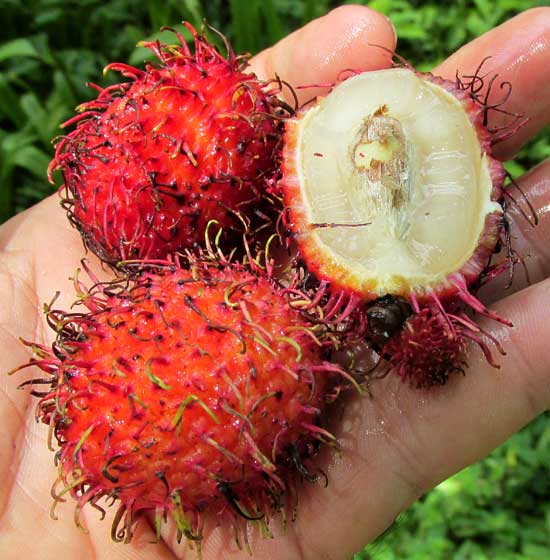Excerpts from Jim Conrad's
Naturalist Newsletter
from the August 21, 2016 Newsletter issued from Hacienda Chichen Resort beside Chichén Itzá Ruins; limestone bedrock; elevation ~39m (~128ft), N20.675°, W88.569°; central Yucatán state, MÉXICO
RAMBUTAN FRUITS
In local frutarías, or fruit stores, something new has been showing up looking like very large, hairy strawberries. Below, you can see some, one of them opened to show the succulent, pale flesh inside surrounding an almond-like seed:

At first I thought these were a hairy race of Litchi, or Lychee, fruit, which we met in Querétaro in 2007, shown at www.backyardnature.net/q/litchi.jpg
When I peeled off the fruit's tough, leathery, red husk and tasted the sweet flesh, finding it a little like that of a big grape, I was even more sure of it. However, on the Internet I couldn't find such a hairy litchi fruit. But when I Googled the keywords "litchi like fruit," there it was.
These are Rambutan fruits, Rambutan being a medium-sized tropical tree in the Soapberry Family, the Sapindaceae, very closely related to the Litchi. The tree is NEPHELIUM LAPPACEUM, native to tropical Southeast Asia.
Apparently Rambutan fruits are becoming popular throughout much of the world. In the Americas, early Rambutan plantations were planted in the coastal lowlands of Colombia, Ecuador, Honduras, Costa Rica, Trinidad and Cuba. In the 1950s efforts to grow them in the US failed, except in Puerto Rico, mostly because the tree suffers from temperatures below 50°F (10°C).
I read that Rambutan trees do best in deep clay loam or sandy loam rich in organic matter, and thrive best on hilly terrain because they require good drainage. Since we don't have that kind of soil in the Yucatan, I suspect that our local fruits are being trucked here from a fair distance away, maybe Chiapas where such soil is found.